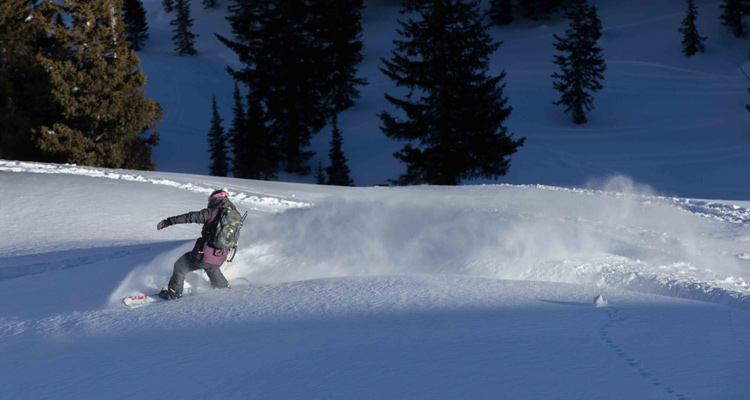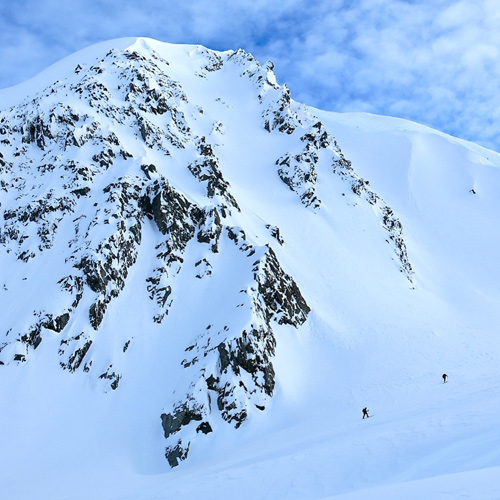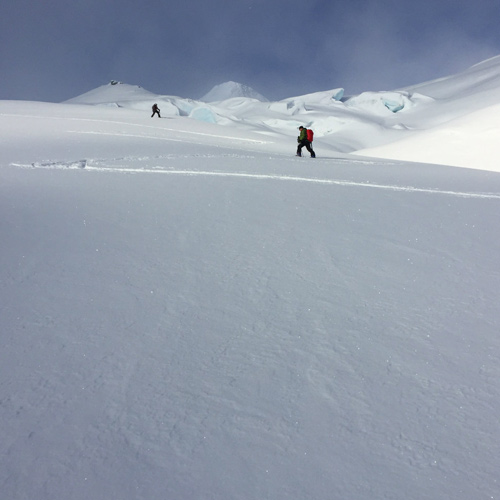Like every gratifying, adventurous inclination, splitboarding involves a sometimes funny, sometimes frustrating progression for resort-turned-backcountry snowboarders. Most riders learn to snowboard inbounds and then make a transition to the backcountry. Because of this, using two planks to climb a mountain and mastering additional uphill travel skills can be daunting.
So to glide off on the right foot, here are four, easy-to-practice ascent techniques.

MacKenzie Ryan sidehills across a sun-affected face in the Solitude sidecountry. | Solitude, Utah| Photo: Gregg Trawinski
Pole Properly for Good Posture
If you are a snowboarder, you probably haven’t used poles since the last time you skied in middle school. Both novice splitboarders and backcountry skiers have the tendency to put too much pressure on their poles as they skin uphill.
Don’t grip your pole to keep from sliding backwards. This will make you hunch and break at the waist. This has the unfortunate side effect of putting too much weight into your toes, forcing your skins to slide downhill.
Stay balanced. Keep your upper body stacked and your head and shoulders upright. If your poles are too short, your upper body will hunch. If your poles are too long, your upper body will bend backward slightly. Spend the time to find the right pole length for this upright posture.
Try keeping your poles at a length that creates a loose, right angle between your forearm and bicep, and adjust them according to the slope angle of your skintrack. Shorten your poles as you climb up steeper terrain and lengthen them as you skin across flat terrain.
Guide tip: AMGA Guide and Splitboard Guides International founder Eric Layton explains that poles are one of his most important pieces of gear. “Most snowboarders don’t ride with poles or put them away for the downhill—keep them out,” says Layton. “Not only do they help in flatter terrain, they are great to use for performing hasty test pits and feeling for slabs and density changes within the snowpack.”

MacKenzie Ryan enjoys the descent after earning her turns. Photo: Gregg Trawinski
Skin Across Sidehills without Slipping
When you sidehill, one split ski will be higher than the other. This can be uncomfortable and challenging, because your skins aren’t in full contact with the snow. Your goal is threefold: get purchase from both skins, keep your balance and engage your split skis’ sidecut.
To maximize purchase from both skins, match your split skis to the sidehill’s angle. Tilt your downhill split ski laterally, letting the skin make full contact with the off-camber slope. The skin will hold your downhill split ski and allow you to skin along the sidehill.
To keep your balance, focus on posture and poling—hold your chest up. Instead of shortening your poles, leave them both extended and choke up on the uphill pole to support your stacked upper body.
To engage your sidecut, dig your downhill ski’s inside edge into the sidehill. If your uphill ski washes out, Layton suggests removing it, bootpacking with your uphill foot and scribing your outside ski along the slope of your traverse.
Guide tip: When you need to sidehill on steep terrain, Layton recommends using your poles to help edge along firm snow-traverses. “Place your outside pole tip right on the outside edge of your splitty and use little shuffling steps to work your way across,” explains Layton. “Having your pole there will prevent your edge from slipping out.”

MacKenzie Ryan and partner head out to the Berlin Wall. | Valdez, Alaska | Photo: Mary Gootjes
Split ski runouts and easy, rolling terrain
Inch for inch, this may be the most awkward movement in all of splitboarding. Even a 15-degree slope can seem unsettling.
Build comfort in pointing your split skis downhill starting on low-angle, nearly flat runouts and work up to short downhills of five feet or less. Avoid pizza wedging because your split skis will become unstable. Remember to sink your weight into your heels. If you’re quads are burning, your weight is probably too far into your toes—which you can get away with in soft snow, but not firm snow.
Guide tip: Layton recommends using an orange Voile strap around your binding’s highback and ankle to give you that hardboot feel for better edge engagement. “If it’s too slick, try leaving your skins on, especially if you have a low-traction type of skin,” says Layton. “As you get more comfortable you can start to remove them and enjoy the speed of skiing in split mode.”

MacKenzie Ryan sets kickturns up Worthington Glacier with ski mountaineer and guidebook author Matt Kinney in tow. | Valdez, Alaska | Photo: Mary Gootjes
Set efficient kickturns to save energy
Kickturns are a multi-step affair. As you practice them, think about each step in succession.
Find a gradual, preferably sub-15-degree route up your objective. Identify a nice, flattish spot to set your kickturn so you’re not burning your legs going straight uphill.
Balance on your downhill ski and then set your uphill ski facing your new direction. As you move your downhill ski to meet your uphill ski in the skintrack, move your heel towards your butt to prevent your split ski tip from catching snow.
Guide tip: “Don’t try to hammer up a steep face by kickturning your way up, unless there is no other choice,” says Layton. “Choose lines that flow through the terrain where you can do a nice, round turn. This will save energy overall and be more efficient in the long run. Get comfortable and efficient with your kickturns [by practicing them] on flat, gentle terrain.”
Bottom Line: If you’re new to splitboarding, don’t despair. The potentially awkward steps you take to improve ascents are part of a process all splitboarders must face. Every photograph you see of a hardcore splitboarder skinning a huge, Alaskan ridgeline begins with that same athlete fumbling as he or she learns to pole, split ski, sidehill and kickturn. And every splitboard outing you take gets you one skintrack closer to a solid set of uphill travel skills.
—
MacKenzie Ryan is a sponsored snowboard athlete, writer and Snowboard Editor At-Large for Teton Gravity Research.










Related posts:
Boardroom: An interview with Pallas Snowboards co-founder Stephanie Nitsch
Boardroom: Franco Snowshapes gets quantum with snowboard design
Boardroom: From Mall Shop Manager to Snowboard Brand Owner, Mason Davey Follows His Own Path
Boardroom: A look into the life of a Rocket Scientist splitboard revolutionary